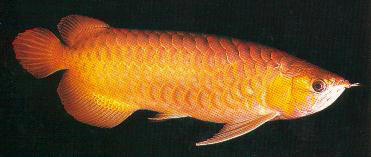| Data Sheet | ||
| Scientific Name: | Scleropages Formosus | |
| Other Names: | Arawana, Dragon Fish | |
| Family: | Osteoglossidae | |
| Origin: | Asia, Australia, Africa, | |
| Adult Size: | 90cm (55-58 inches) | |
| Social: | Predatory fish that will eat up smaller fishes. Highly territorial | |
| Lifespan: | 10-20 years. | |
| Tank Level: | mid-top dweller. | |
| Minimum Tank Size: | At least 3 times the width of your Arowana, and width same as Arowana length. | |
| Diet: | Eats anything - live crickets, tapdoles, small frogs, small fishes, shrimps etc. | |
| Breeding: | Mouthbrooder | |
| Care: | Easy - Hardly fish | |
| Ideal pH: | 6.5-7 | |
| Temperature: | 75-85 F (24-29C) | |
| Tank setup: | No plants or rocks recommended as this fish needs lots of space and plants and rocks may get in their way. | |
| Sexing: | The male's mouth is wider and deeper. | |
|
| Description:In this family of fishes, the head is bony and the elongate body is covered by large, heavy scales, with a mosaic pattern of canals. The dorsal and the anal fins have soft rays and are long based, while the pectoral and ventral fins are small. The name 'bony tongues' is derived from a toothed bone on the floor of the mouth, the 'tongue', equipped with teeth that bite against teeth on the roof of the mouth. Habitat/Care:In the wild, the Arowanas prefers to stay in shallow waters (above five feet deep), near riverbanks and in shaded areas. Arowanas prefer these areas not because they are avoiding the elements, but because insects are plentiful in shaded areas and these are their main source of food. Mixing with other fishes:Medium to Large bottom feeders are ideal tank mates for the Arowana. The Arowana will leave these bottom feeders alone. Other peaceful large fish may be safety kept with Arowana. Take care not to include fin-nippers with the Arowana. Smaller fish that will fit into the Arowana mouth will be eaten. Arowanas are generally highly territorial and will not tolerate another Arowana in a small tank. In a large open pond, however, it has been noted that several Arowanas can be safety kept together. Wikipedia recommends that 5-6 Arowanas should be kept together in a tank instead of 2-3 as when in a group, their aggressiveness tends to be subdued. Diet:Arowana prefer live food or at the very least floating food. They will generally not eat from the bottom of the tank. To this end keeping your Arowana with a suitable bottom feeder may be a good idea. |
| |
Photo Galley
Got a photo? Contact me.
 A superb red arowana |  Gold, blue scales | |
 A Gold Arowana with black scales |  Super Shiny Gold Arowana | |
 Red Arowana |  Gold Arowana | |
Links to other awesome Arowana sites:
1. http://www2.wbs.ne.jp/~arowana/egallery.htm Awesome Photo Galley of Arowana kept by Japanese
2. http://www.luckytropical.com/english/arowana.asp?cat=Red%20Tail%20Arowana&pgno=1&lang=en Another good photo galley.
3. http://arowanaclub.com/gallery/ Amazing collection of Arowana photos.
References Cited:
1. K.K.P Lim & P.K.L Ng, 2000, A Guide to the Freshwater Fishes of Singapore, Singapore Science Center.
2. Billy Lim, 1999, Types of Arowana, [Online], Available http://web.singnet.com.sg/~lin1629/Types.html
3. Dragon Fish Industry, [Online], Available http://dragonfish.com/
4. Arowana Dragon Fish feeding Information, [Online], Available http://www.arowana.co.uk/feeding-arowana.htm
5. Arowana General Care [Online], Available, http://www.aquariumhobbyist.com/ozarowana/care.html
6. Silver arowana - Wikipedia [Online], Available http://en.wikipedia.org/wiki/Silver_arowana
7. Arowana Breeding [Online], Available http://arowana8.tripod.com/Arowana/breeding.html































No comments:
Post a Comment